Ever wonder how to use social media to increase engagement for your business? Or how social media can improve awareness, credibility, and conversation?
The key is consistently showing up, but for that, you need a social media plan. Part of that strategy includes the daily, weekly, and monthly tasks that keep you focused and on point.
If you've been drowning in a sea of social media to-do's, the social media checklist below is exactly what you need. Check out the Infographic and then download the only social media checklist you'll ever need!
The only social media checklist you'll ever need
via Michael Patterson, Sprout Social
1. Finish any outstanding tasks
Are there any customer support tickets or inquiries lingering from the day prior? Make sure to finish these first since those customers have already been waiting and deserve a response.
2. Respond to inbound social messages
Check your inbox to see if any new social media messages have come through that require your response. Continue to monitor your inbox throughout the day and make sure you’re engaging with inquiries in a timely manner.
3. Monitor and respond to untagged brand mentions
Not every person who mentions your brand on social will tag your page directly. Monitor social media for your brand and product keywords to find conversations that you should join. Here’s an example of the restaurant Jimmy John’s finding and joining a conversation about their brand that didn’t directly tag them.
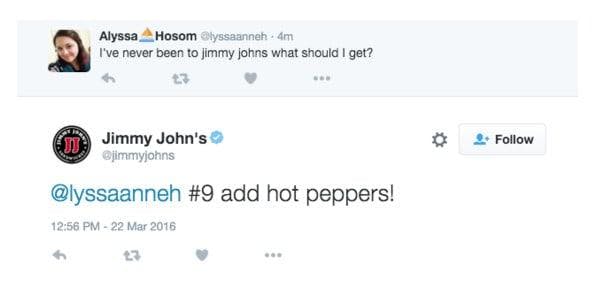
4. Find and engage with potential customers
It’s key to track keywords about your brand, but it’s also a good idea to track adjacent keywords as well since they often indicate when someone is looking to purchase a product like yours. If you identify those instances, you can join the conversation. To build off our above example, Jimmy John’s may monitor social media for a keyword like “delivery” or “slow delivery”, then engage with any messages mentioning those phrases.
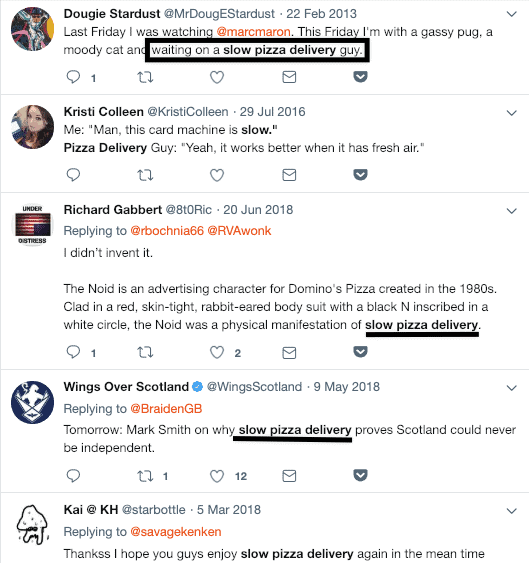
5. Load your social media content calendar
Publishing engaging, relevant content is one of the best ways to grow your following and keep your current following engaged with your brand. Take some time to search for great content and schedule your social posts months or weeks in advance to stay ahead. If you don’t have a content process in place, check out this article about how to create a unique social media calendar. Try a social media scheduling tool like Sprout to help you build out your content calendar.
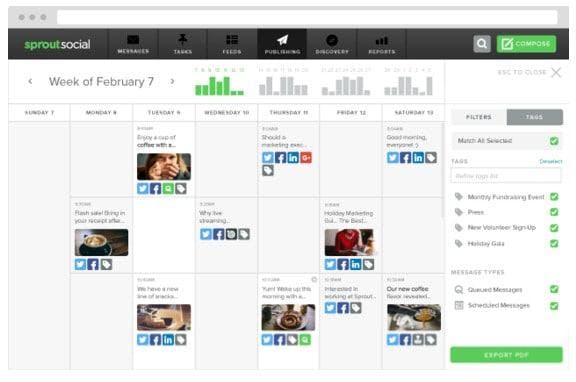
The frequency with which you should schedule to the various social networks isn’t universal, but here are some jumping off points:
- Post 6-9 times per day to Twitter
- Post 1-2 times per day to Facebook
- Post 1-2 times per day to Google+
- Post 1-3 times per day to Instagram
- Post 1-2 times per day to LinkedIn
6. Stay up-to-date on the social industry
Social networks are constantly updating their functionality. If you want to stay ahead of your competition, you should monitor and understand those changes and make the necessary changes in your strategy to make the most of them. If you’re looking for new social media blogs to follow, check out Social Media Examiner’s list of Top 10 Social Media Blogs, which includes:

7. Create unique social images to share
If a picture is worth 1,000 words, and the average length of an English word is 5 letters, it would take you 35.71 Tweets to tell the same story you could with one shared image on social media. So why not spend some time creating great social media images?
After you’ve created a beautiful image to share, use a free social media image resizing tool like Landscape by Sprout to optimize it for each social media network and post type.
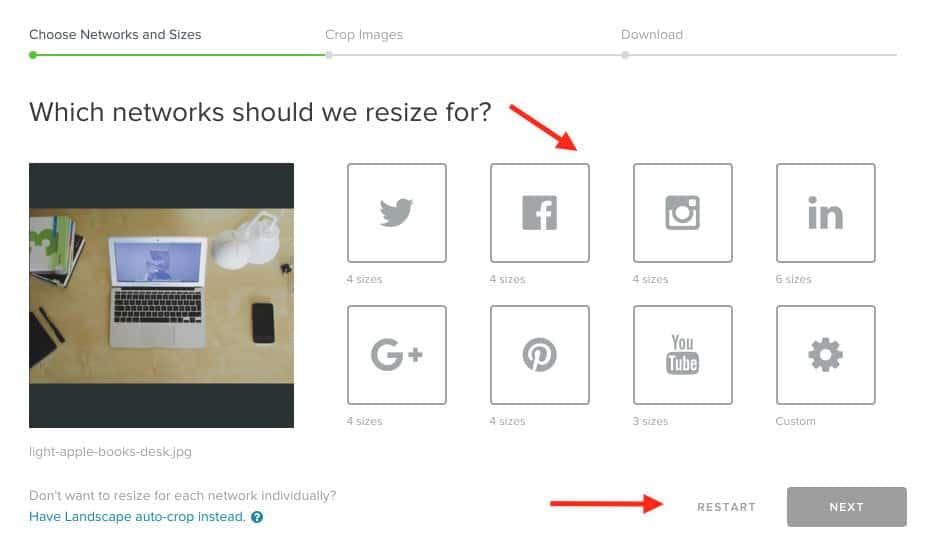
8. Check your competitions presence
Don’t obsessively monitor your competition’s social media presence, and definitely don’t try to emulate everything they do; however, keep an eye on how they’re leveraging their social channels. It can help you stay on top of their new releases, identify gaps in the marketplace and provide ideas for ways to differentiate yourself. If you really want to go after your competition on social media, check out this article by Rebekah on how to measure and track your social media performance.
9. Create content
Content still reigns king in online marketing and you should spend some time creating quality content that your community will read and share with their followers. If you’re not sure what to create, look to your past social media post success to help inform your future content.
10. Study your brand
If your company has a large product offering–or if you work at an agency managing many different companies–it’s important to study and truly understand the products you’ll need to answer questions about. This will reduce the time it takes for you to respond to your inbound queries.
11. Manage your personal profiles
Creating your own personal social presence helps establish you as a thought leader in your industry and position you as a more credible resource.

Weekly social media marketing tasks
12. Engage with thought leaders
Creating and maintaining relationships with the thought leaders in your industry can help you get your product in front of larger, qualified audiences. For example, Peg Fitzpatrick is an amazing thought leader in the social media space and we’re always excited to share the content she produces.

And of course the very same goes for the ever-fantastic Rebekah Radice.

13. Engage with marketing partners
Many companies have great working relationships with companies in similar industries, whether that’s due to product integration or a piece of co-created content. Continue to engage with these partners to keep that relationship alive.
14. Discuss tactics with your team
If you work on an account large enough to require a team–or at an agency with several different social media managers–spend some time collaborating and discussing the strategies, you’ve found to be successful.
15. Update your calendar with events
Knowing what events you have coming up can help you schedule social content you know will resonate. Whether it’s a national holiday or a company conference, use those events to inform the social posts that you schedule. You can also use Twitter’s fun trending Hashtag Holidays, like #NationalBeerDay, to inspire your content. Check out this article for a full list of hashtag holidays.
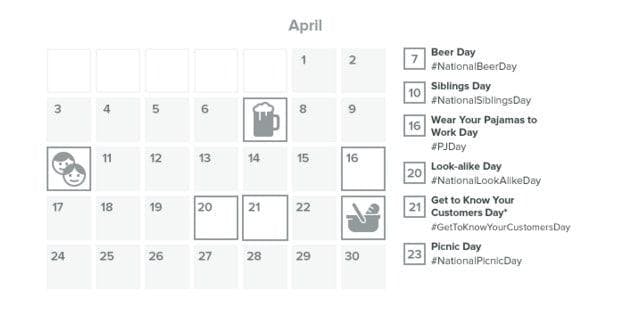
16. Run your social media data
You should run your social media analytics at least once a week to see what is working on social and what could be trimmed from your strategy. Ask yourself pertinent questions, such as:
- What kind of content is getting shared?
- How quickly am I responding to people?
- Which team members contribute the most?
- Is your audience discussing anything new or exciting you can tap into?
Rebekah has a great post on how to improve your social presence using data.
17. Encourage sharing with advocacy
Employee advocacy is the idea of encouraging your employees to share your content with their own social communities, thereby increasing your overall social media reach. Try an Employee Advocacy Tool like Bambu to help facilitate this process.
18. Attend a Twitter chat
Twitter Chats are a great way to connect with your social media peers, learn new strategies, and grow your own social media presence. Check out this list of Twitter Chats to find some relevant for you, and go out and participate!
Monthly social media marketing tasks
19. Run a social media audit
You should look at your social analytics at least once a week, but once a month, you should do a much deeper dive into the data by running a social media audit. This can help shed light on more specific questions, like:
- What message copy works?
- Which locations are effective?
- Which social networks should I re-think?
20. Attend local social media events
While it’s important to be social online, nothing can replace a face-to-face meeting. Look for upcoming social media events and go out there to meet and engage with your fellow social media professionals.
21. Step away from social media
This one may sound strange, but it’s important to take breaks from social media. Social media managers frequently need to be on-call 24-7, so taking a short break can help prevent any sort of social media burnout.
22. Collaborate with other departments
Social media has a ton of benefits beyond marketing and is great for customer service, sales, human resources, and more. Spend some time collaborating with other departments and learn how they could benefit from a more robust social presence. Check out this amazing post by Rebekah on 33 Ways to Use Social Media to Make Sales to learn how sales can benefit from social.
Quarterly social media marketing tasks
23. Pull performance reports
Most departments report success on a quarterly basis, so it could benefit for you to do the same. Use a social media reporting tool to download presentation-ready social media reports.
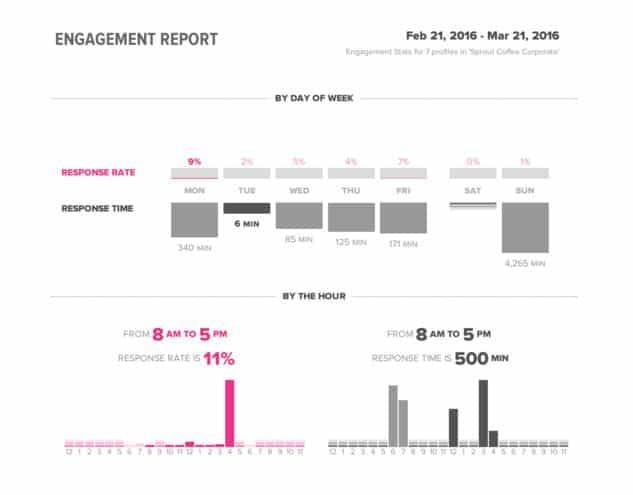
24. Report to your stakeholders
Once you have your reports ready to go, make sure to share them with all of the stakeholders. This will help you illustrate the importance of social media as a channel for your brand.
25. Adjust your goals
Did you surpass your social media goals for the quarter? Maybe it’s time to give them a bit of a boost. Did you fall short of the goals you had for social media? Spend some time figuring out why and adjust your new goals accordingly.
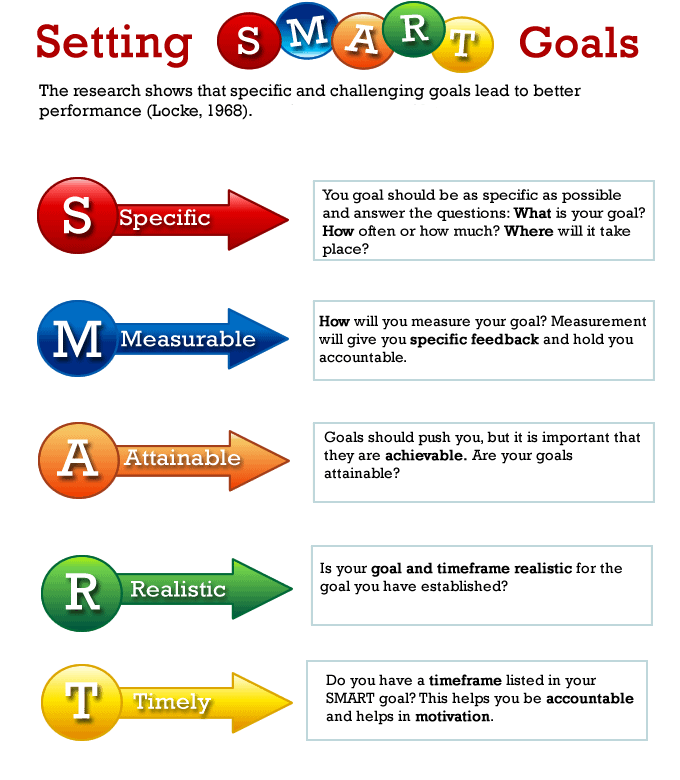
26. Assess your key performance indicators
Your key performance indicators are the metrics that help you achieve your goal, like your social impressions, clicks, and engagement. Make sure the KPIs you’re looking at are helping you reach your new goal.
27. Gauge team capacity and needs
If you hit your goal and see great potential to grow social media, it may be time to get someone else on your team to come help you scale. Inversely, if you fell short of your goals because there was too much activity for one person to handle, you may need to bring in someone to assist you.
28. Re-evaluate your social crisis plan
There are so many horror stories online of a brand’s social profile being hacked or of an employee sharing out something distasteful across social. Make sure that you have an up-to-date plan to handle in place so you’re ready to handle any such crisis that occurs.
Immediate social media marketing tasks
29. Print out this social media checklist
Whether you bookmark this page or print out a physical version of the infographic, make sure you have it handy to keep track of all of the social media activities you need to get done.
30. Start a Free Sprout Social Trial
Sprout Social is a social media management tool with a full suite of features that help you engage with your customers, schedule and queue content and run robust analytics on your social performance. Are there any additional activities on your list? Let us know in the comments and we’ll make sure to include that feedback in our next version of the Social Media Manager’s Checklist!
Grab and SHARE the infographic

About Rebekah Radice
Rebekah Radice, co-founder of BRIL.LA, has traded narcissism for purpose. When not driving growth, you'll find her tricking family into thinking she's Emeril Lagasse - likely covered in marinara. The spotlight was fun, but impact is better. These days she's using 20+ years of brand brilliance for good.
